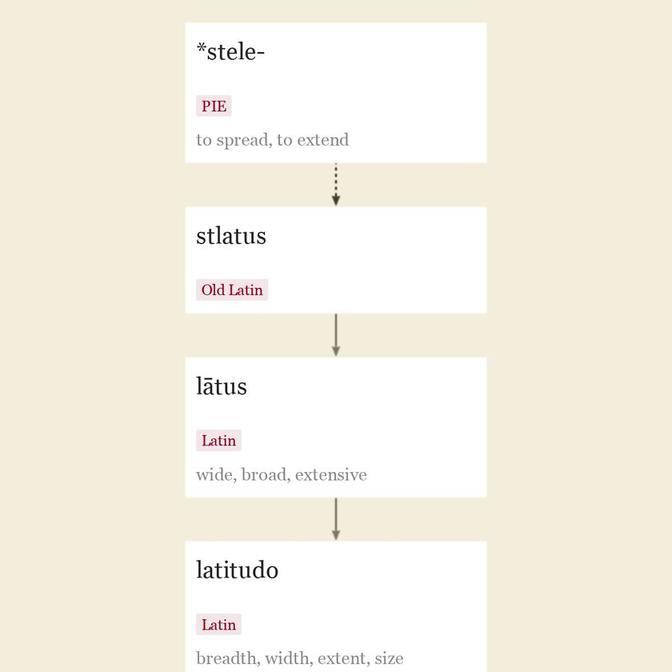latitudinarian (adj.)
1660年代,“具有宽容心的”,特别是指17世纪的圣公会牧师对教义细节漠不关心; 这是一个伪拉丁构造,由 latitude 的意思“摆脱狭隘限制”(约1600年)和 sectarian 等结尾组成。自1660年代起也用作名词。相关词汇: Latitudinarianism “宗教观点的宽容”(1670年代); 早期的词汇是 latitudinism(1660年代)。
最早记录年份: 1660s
latitudinarian 的相关词汇
latitude (n.)

14世纪晚期,“宽度”,来自古法语 latitude(13世纪)和直接源自拉丁语 latitudo “宽度,宽度,范围,大小”,来自 lātus(形容词)“宽,广,广泛”的古拉丁语 stlatus,源自 PIE *stleto-,是 *stele- “扩散,扩展”的后缀形式(源头还包括古教会斯拉夫语 steljo “展开”,亚美尼亚语 lain “宽”)。
地理和天文学意义也来自14世纪晚期,字面意思是已知世界地图的“宽度”。比喻意义上的“允许的变化程度,偏离标准的范围”早在15世纪就出现了。相关词汇: Latitudinal “与地理纬度有关的”(1777); latitudinous “解释宽泛的”(1829,美国英语)。
The ancients supposed the torrid and the frigid zones to be uninhabitable and even impenetrable by man, but while the earth, as known to them, was bounded westwardly by the Atlantic Ocean, it extended indefinitely towards the east. The dimensions of the habitable world then (and ancient geography embraced only the home of man ....,) were much greater, measured from west to east, than from south to north. Accordingly, early geographers called the greater dimension, or the east and west line, the length, longitudo, of the earth, the shorter dimension, or the north and south line, they denominated its breadth, latitudo. These Latin terms are retained in the modern geography of most European nations, but with a modified meaning. [George P. Marsh, "Lectures on the English Language," 1882]
古人认为热带和寒带是不适宜居住的,甚至是人类无法穿越的,但当他们所知道的地球向西被大西洋所限制时,它向东无限延伸。因此,早期地理学家称更大的尺寸或东西线为地球的 length,长度,较短的尺寸或南北线则称为 breadth,宽度。这些拉丁术语在大多数欧洲国家的现代地理学中仍然保留,但含义有所改变。[乔治·P·马什,“英语语言讲座”,1882年]
sectarian (adj.)
1640年代,“属于分裂派的”一词,由长老会派给独立派使用,源自中世纪拉丁语 sectarius,来自 secta “宗教团体,哲学或宗教中的派别”(见 sect)。到1796年,“属于派别或对特定派别的附着; 包括派别的信条”,因此“顽固地附着于一个派别”。Sectarial(1816)“主要用于印度宗教”[OED]。
作为名词,“一个派别的人”(1650年代),特别是“过分重视一个派别的人”。这个意义上的旧词是 sectary。